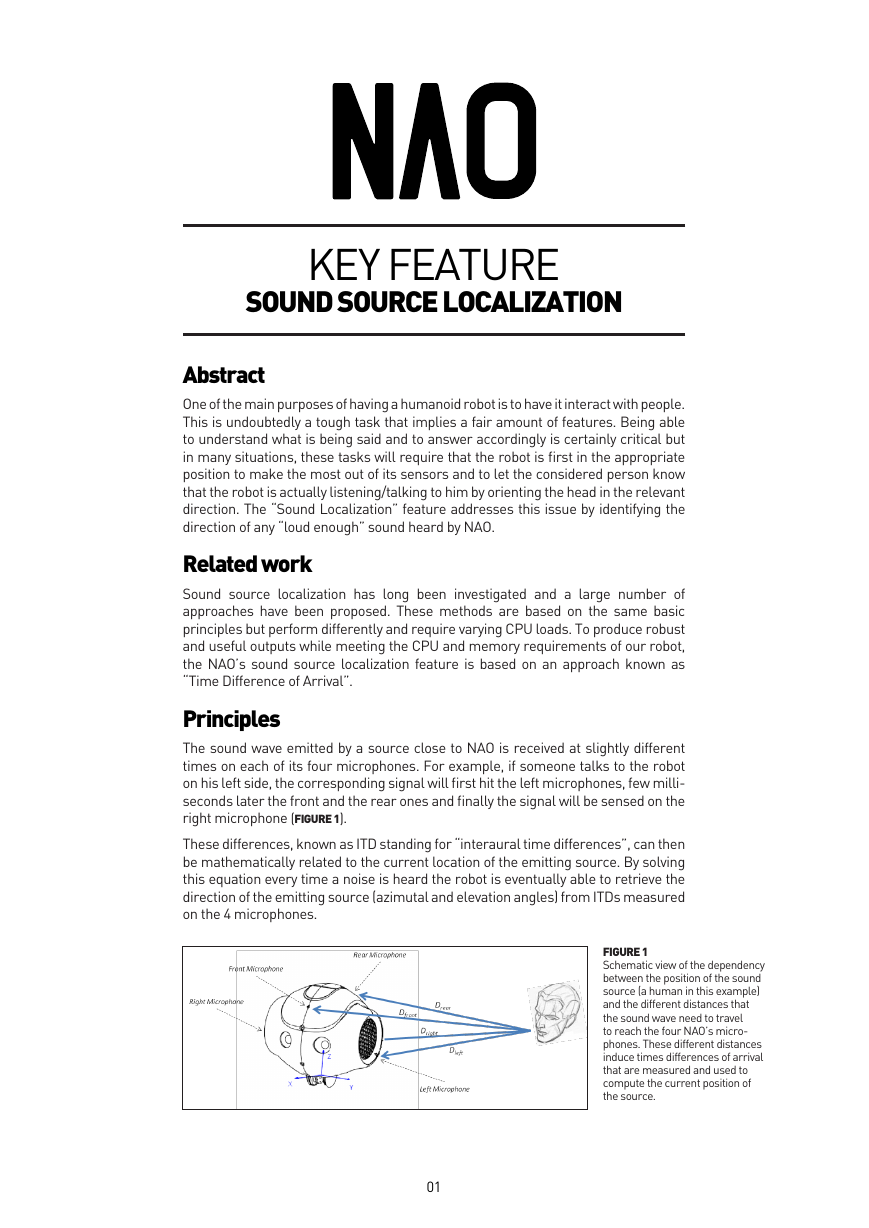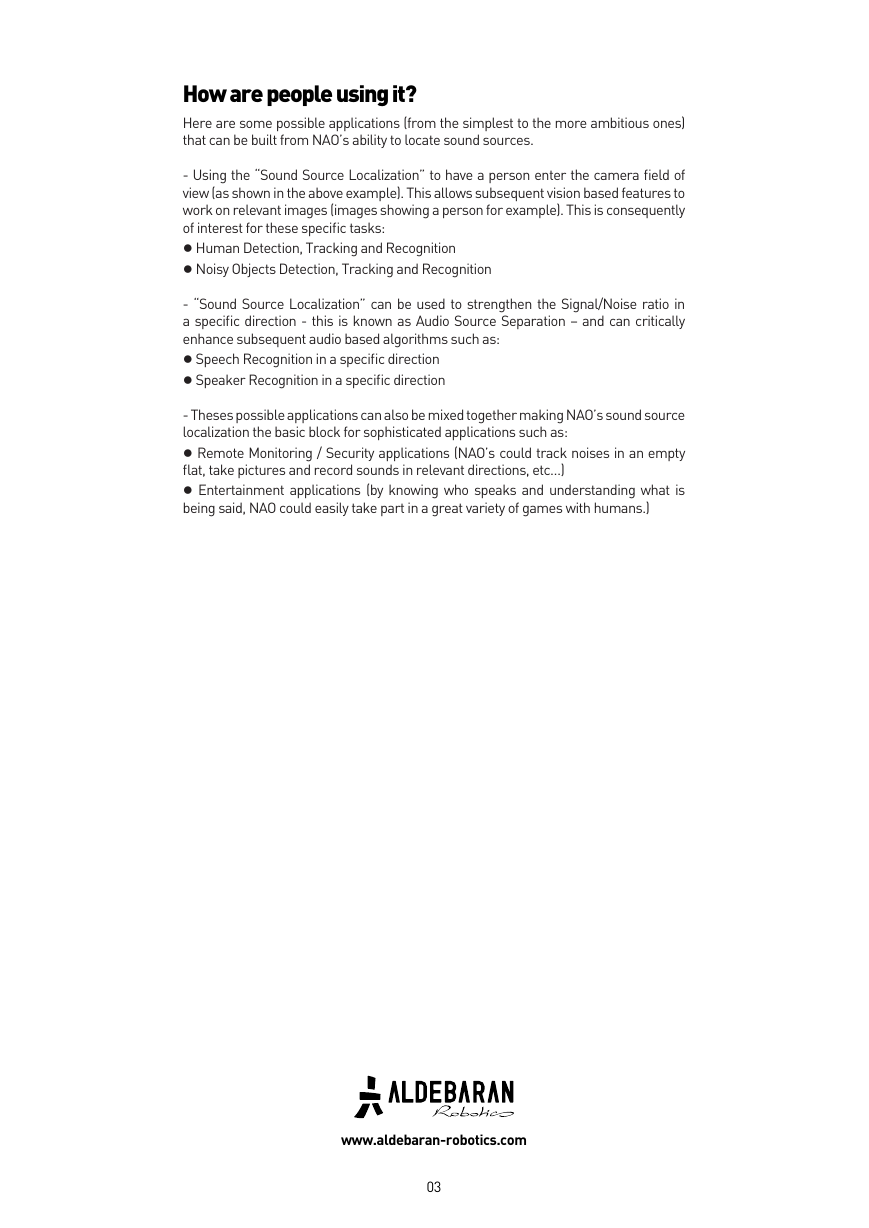KEY FEATURE
SOUND SOURCE LOCALIZATION
Abstract
One of the main purposes of having a humanoid robot is to have it interact with people.
This is undoubtedly a tough task that implies a fair amount of features. Being able
to understand what is being said and to answer accordingly is certainly critical but
in many situations, these tasks will require that the robot is first in the appropriate
position to make the most out of its sensors and to let the considered person know
that the robot is actually listening/talking to him by orienting the head in the relevant
direction. The “Sound Localization” feature addresses this issue by identifying the
direction of any “loud enough” sound heard by NAO.
Related work
Sound source localization has long been investigated and a large number of
approaches have been proposed. These methods are based on the same basic
principles but perform differently and require varying CPU loads. To produce robust
and useful outputs while meeting the CPU and memory requirements of our robot,
the NAO’s sound source localization feature is based on an approach known as
“Time Difference of Arrival”.
Principles
The sound wave emitted by a source close to NAO is received at slightly different
times on each of its four microphones. For example, if someone talks to the robot
on his left side, the corresponding signal will first hit the left microphones, few milli-
seconds later the front and the rear ones and finally the signal will be sensed on the
right microphone (FIGURE 1).
These differences, known as ITD standing for “interaural time differences”, can then
be mathematically related to the current location of the emitting source. By solving
this equation every time a noise is heard the robot is eventually able to retrieve the
direction of the emitting source (azimutal and elevation angles) from ITDs measured
on the 4 microphones.
FIGURE 1
Schematic view of the dependency
between the position of the sound
source (a human in this example)
and the different distances that
the sound wave need to travel
to reach the four NAO’s micro-
phones. These different distances
induce times differences of arrival
that are measured and used to
compute the current position of
the source.
01
�
Performances
The angles provided by the NAO’s sound source localization engine match the real
position of the source with an average accuracy of 20 degrees, which is satisfactory
in many practical situations. Note that the maximum theoretical accuracy depends
on the microphones’ spatial configuration and on the sample rate of the measured
signal, and is about 10 degrees on NAO.
The distance separating NAO and a sound source successfully located can reach
several meters depending on the situation (reverberation, background noise, etc…).
Once launched, this feature uses 10% of the CPU constantly and up to 20% for few
milliseconds when the location of a sound is being computed.
Limitations
The performance of NAO’s sound source localization is limited by how clearly the
sound source can be heard with respect to background noise. Noisy environments
naturally tend to decrease the reliability of the module outputs.
It will also detect and locate any “loud sounds” without being able by itself to filter
out sound source that are not humans.
Finally, only one sound source can be located at a time. The module can behave in a
less reliable manner if NAO faces several loud noises at the same time. He will likely
only output the direction of the loudest source.
How does it work?
This feature is available as a NaoQi module named “ALAudioSourceLocalization”
which provides a C++ and Python API (application programming interface) that
allows precise interactions from a python script or a NaoQi module.
Two boxes in Choregraphe are also available that allow an easy use of the feature
inside a behavior:
● The box “Sound Loc.” provides the output (angles and level of confidence) of the
sound localization module without taking any further actions.
● The box “Sound Tracker” uses these outputs to make NAO’s head turn in the
appropriate direction.
FIGURE 2
An example of a behavior using
the «Sound Tracker» box to
orientate NAO’s head so that
the «Face Recognition» box can
actually perform its recognition.
02
�
How are people using it?
Here are some possible applications (from the simplest to the more ambitious ones)
that can be built from NAO’s ability to locate sound sources.
- Using the “Sound Source Localization” to have a person enter the camera field of
view (as shown in the above example). This allows subsequent vision based features to
work on relevant images (images showing a person for example). This is consequently
of interest for these specific tasks:
● Human Detection, Tracking and Recognition
● Noisy Objects Detection, Tracking and Recognition
- “Sound Source Localization” can be used to strengthen the Signal/Noise ratio in
a specific direction - this is known as Audio Source Separation – and can critically
enhance subsequent audio based algorithms such as:
● Speech Recognition in a specific direction
● Speaker Recognition in a specific direction
- Theses possible applications can also be mixed together making NAO’s sound source
localization the basic block for sophisticated applications such as:
● Remote Monitoring / Security applications (NAO’s could track noises in an empty
flat, take pictures and record sounds in relevant directions, etc…)
● Entertainment applications (by knowing who speaks and understanding what is
being said, NAO could easily take part in a great variety of games with humans.)
www.aldebaran-robotics.com
03
�






 2023年江西萍乡中考道德与法治真题及答案.doc
2023年江西萍乡中考道德与法治真题及答案.doc 2012年重庆南川中考生物真题及答案.doc
2012年重庆南川中考生物真题及答案.doc 2013年江西师范大学地理学综合及文艺理论基础考研真题.doc
2013年江西师范大学地理学综合及文艺理论基础考研真题.doc 2020年四川甘孜小升初语文真题及答案I卷.doc
2020年四川甘孜小升初语文真题及答案I卷.doc 2020年注册岩土工程师专业基础考试真题及答案.doc
2020年注册岩土工程师专业基础考试真题及答案.doc 2023-2024学年福建省厦门市九年级上学期数学月考试题及答案.doc
2023-2024学年福建省厦门市九年级上学期数学月考试题及答案.doc 2021-2022学年辽宁省沈阳市大东区九年级上学期语文期末试题及答案.doc
2021-2022学年辽宁省沈阳市大东区九年级上学期语文期末试题及答案.doc 2022-2023学年北京东城区初三第一学期物理期末试卷及答案.doc
2022-2023学年北京东城区初三第一学期物理期末试卷及答案.doc 2018上半年江西教师资格初中地理学科知识与教学能力真题及答案.doc
2018上半年江西教师资格初中地理学科知识与教学能力真题及答案.doc 2012年河北国家公务员申论考试真题及答案-省级.doc
2012年河北国家公务员申论考试真题及答案-省级.doc 2020-2021学年江苏省扬州市江都区邵樊片九年级上学期数学第一次质量检测试题及答案.doc
2020-2021学年江苏省扬州市江都区邵樊片九年级上学期数学第一次质量检测试题及答案.doc 2022下半年黑龙江教师资格证中学综合素质真题及答案.doc
2022下半年黑龙江教师资格证中学综合素质真题及答案.doc